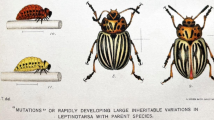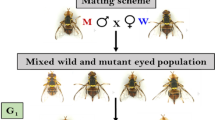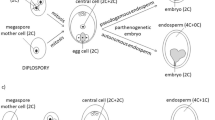Abstract
Mealybugs have a haplodiploid reproduction system, with paternal genome elimination (PGE); the males are diploid soon after fertilization, but during embryogenesis, the male paternal set of chromosomes becomes heterochromatic (HC) and therefore inactive. Previous studies have suggested that paternal genes can be passed on from mealybug males to their sons, but not necessarily by any son, to the next generation. We employed crosses between two mealybug species—Planococcus ficus (Signoret) and Planococcus citri (Risso)—and between two populations of P. ficus, which differ in their mode of pheromone attraction, in order to demonstrate paternal inheritance from males to F2 through F1 male hybrids. Two traits were monitored through three generations: mode of male pheromone attraction (pherotype) and sequences of the internal transcribed spacer 2 (ITS2) gene segment (genotype). Our results demonstrate that paternal inheritance in mealybugs can occur from males to their F2 offspring, through F1 males (paternal line). F2 backcrossed hybrid males expressed paternal pherotypes and ITS2 genotypes although their mother originated through a maternal population. Further results revealed other, hitherto unknown, aspects of inheritance in mealybugs, such as that hybridization between the two species caused absence of paternal traits in F2 hybrid females produced by F1 hybrid females. Furthermore, hybridization between the two species raised the question of whether unattracted males have any role in the interactions between P. ficus and P. citri.





Similar content being viewed by others
References
Abbot JK, Innocenti P, Chippindale AK, Morrow EH (2013) Epigenetics and sex-specific fitness: an experimental test using male-limited evolution in Drosophila melanogaster. Plos One 8:1–9
Avner P, Heard E (2001) X-chromosome inactivation: counting, choice and initiation. Nat Rev Gen 2:59–67
Bierl-Leonhardt BA, Moreno DS, Schwarz M, Fargerlund J, Plimmer JR (1981) Isolation, identification and synthesis of the sex-pheromone of the citrus mealybug, Planococcus citri (RISSO). Tetrahedron Lett 22:389–392
Bongiorni S, Prantera G (2003) Imprinted facultative heterochromatinization in mealybugs. Genetica 117:271–279
Bongiorni S, Cintio O, Prantera G (1999) The relationship between DNA methylation and chromosome imprinting in the coccid Planococcus citri. Genetics 151:1471–1478
Brown SW, Nur U (1964) Heterochromatic chromosomes in Coccids. Science 145:130–136
Cook JM (1993) Sex determination in the Hymenoptera: a review of models and evidence. Heredity 71:421–435
Cox JM (1981) Identification of Planococcus citri (Homoptera: Pseudococcidae) and the description of a new species. Syst Entomol 6:47–53
Cox JM (1983) An experimental study of morphological variation in mealybugs (Homoptera: Coccoidea: Pseudococcidae). Syst Entomol 4:361–382
Cox JM (1989) The mealybug genus Planococcus (Homoptera: Pseudococcidae). Bull Brit Mus (Nat Hist) Entomology (UK) 58:1–78
Edgar RC (2004) MUSCLE: multiple sequence alignment with high accuracy and high throughput”. Nucleic Acids Res 32:1792–1797
Graves JAM (1994) Mammals that break the rules: genetics of marsupials and monotremes. Ann Rev Genet 30:233–260
Gray HE (1954) The development of the citrus mealybug. J Econ Entomol 47:174–176
Gullan PJ, Kosztarab M (1997) Adaptations in scale insects. Annu Rev Entomol 42:23–50
Hartmann-Goldstein IJ (1967) On the relationship between heterochromatinization and variegation in Drosophila, with special reference to temperature-sensitive periods. Genet Res 10:143–201
Heard E, Clerc P, Avner P (1997) X-chromosome inactivation in mammals. Ann Rev Genet 31:571–610
Heard E, Rougeulle C, Arnaud D, Avner P, Allis CD, Spector DL (2001) Methylation of histone H3 at Lys-9 is an early mark on the X chromosome during X inactivation. Cell 107:727–738
Hinkens DM, McElfresh SJ, Millar JG (2001) Identification and synthesis of the sex pheromone of the vine mealybug Planococcus ficus. Tetrahed Lett 42:1619–1621
Kol-Maimon H, Zada A, Franco JC, Dunkelblum E, Protasov A, Eliyaho M, Mendel Z (2010) Male behaviors reveal multiple pherotypes within vine mealybug Planococcus ficus (Signoret) (Hemiptera; Pseudococcidae) populations. Naturwissenschaften 97:1047–1057
Kol-Maimon H, Ganim M, Franco JC, Mendel Z (2014) Evidence for gene flow between two sympatric mealybug species (Insecta; Coccoidea; Pseudococcidae). Plos One 9:1–10
La Rosa G, Marucci G, Zarlenga DS, Casulli A, Zarnke RL, Pozio E (2003) Molecular identification of natural hybrids between Trichinella native and Trichinella T6 provides evidence of gene flow and ongoing genetic divergence. Int J Parasitol 33:209–216
Lewis SM, Austad SN (1994) Sexual selection in flour beetles: the relationship between sperm precedence and male olfactory attractiveness. Behav Ecol 5:223–224
Lyon MF (1972) X-chromosome inactivation and developmental patterns in mammals. Biol Rev 47:1–35
Malausa T, Fenis A, Warot S, Germain JF, Ris N, Prado E, Botton M, Vanlerberghe-Masutti F, Sforza R, Cruaud C, Couloux A, Kreiter P (2010) DNA markers to disentangle complexes of cryptic taxa in mealybugs (Hemiptera: Pseudococcidae). J App Entomol 135:142–155
Moody ML, Les D (2002) Evidence of hybridity in invasive watermilfoil (Myriophyllum) populations. Proc Nat Acad Sci USA 99:14867–14871
Morgan HD, Sutherland HGE, Martin DIK, Whitelaw E (1999) Epigenetic inheritance at the agouti locus in the mouse. Nat Genet 23:314–318
Normark BB (2003) The evolution of alternative genetic systems in insects. Ann Rev Entomol 48:397–414
Normark BB (2004) Haplodiploidy as an outcome of coevolution between male-killing cytoplasmic elements and their hosts. Evolution 58:790–798
Nur U (1967) Reversal of heterochromatization and the activity of the paternal chromosome set in the male mealy bug. Genetics 56:375–389
Nur U (1982) Destruction of specific heterochromatic chromosomes during spermatogenesis in the Comstockiella chromosome system (Coccoidea: Homoptera). Chromosoma 85:519–530
Nur U (1990) Heterochromatization and euchromatization of whole genomes in scale insects (Coccoidea: Homoptera). Dev Suppl 29–34
Herrick G, Seger J (1999) Imprinting and paternal genome elimination in insects. In: Ohlsson R (ed) Genomic imprinting: an interdisciplinary approach. Springer-Verlag, Berlin, pp 41–71
Okamoto I, Otte A, Allis C, Reinberg D, Heard E (2004) Epigenetic dynamics of imprinted X inactivation during early mouse development. Science 303:644–652
Prantera G, Bongiorni S (2012) Mealybug chromosome cycle as a paradigm of epigenetics. Genet Res Int 2012:1–11
Reik W, Walter J (2001) Genomic imprinting: parental influence on the genome. Nat Rev Genet 2:21–32
Ross L, Pen I, Shuker DM (2010) Genomic conflict in scale insects: the causes and consequences of bizarre genetic systems. Biol Rev 85:807–828
Rotundo G, Tremblay E (1982) Hybridization and sex pheromone response in two closely related mealybug species (Homoptera: Pseudococcidae). Syst Entomol 7:475–478
Sanchez L (2008) Sex determining mechanisms in insects. Int J Dev Biol 52:837–856
Slobodchikoff CN, Daly HV (1971) Systematic and evolutional implications of parthenogenesis in the Hymenoptera. Amer Zool 11:273–282
Stevens JR, Wall R, Wells JD (2002) Paraphyly in Hawaiian hybrid blowfly populations and the evolutionary history of anthropophilic species. Ins Mol Biol 11:141–148
Svensson M (1996) Sexual selection in moths: the role of chemical communication. Biol Rev 71:113–135
Takagi N, Sasaki M (1975) Preferential inactivation of the paternally derived X chromosome in the extraembryonic membranes of the mouse. Nature 256:640–642
Tranfaglia A, Tremblay E (1982) A morphological comparison between Planococcus citri (Risso), Planococcus ficus (Signoret) and their F1 hybrids. Entomotaxonomia 4:1–5
Verma RS (1990) The genome. VCH Publishers, New York
Wakabayashi K, Komatsu M, Murakami M, Hori I, Takegami T (2008) Morphology and gene analysis of hybrids between two congeneric sea stars with different modes of development. Biol Bull 215:89–97
Williams DJ (1985) Australian mealybugs. British Museum (Natural History), London
Wolf GL, Kodell RL, Moore SR, Cooney CA (1998) Maternal epigenetics and methyl supplements affect agouti gene expression in Avy/a mice. FASEB J 12:949–957
Walton VM, Pringle KL (2005) Developmental biology of vine mealybug, Planococcus ficus (Signoret) (Homoptera: Pseudococcidae), and its parasitoid Coccidoxenoides perminutus (Timberlake) (Hymenoptera: Encyrtidae). African Entomol 13:143–147
Wyatt TD (2003) Pheromones and animal behavior. Cambridge University Press, Cambridge
Zada A, Dunkelblum E, Assael F, Harel M, Cojocaru M, Mendel Z (2003) Sex pheromone of the vine mealybug, Planococcus ficus in Israel: occurrence of a second component in mass-reared population. J Chem Ecol 29:977–988
Acknowledgments
The authors wish to thank Dr. Alex Protasov and Miriam Eliyahu for invaluable technical support; Dr. Anat Levi-Zada for her advice and supply of the pheromone solutions; Prof. Uri Lavi-Gefel, Prof. Eva Jablonka, and Dr. Laura Ross, for their guidance concerning inheritance and epigenetic issues; and Dr. Adi Faigenboim for the bioinformatics support. Finally, we wish to greatly thank and acknowledge Prof. Benjamin Normark as he brought to our attention and suggested the hypotheses of the intersexual arm race, which were discussed in the manuscript.
Author information
Authors and Affiliations
Corresponding author
Additional information
Communicated by: Sven Thatje
Rights and permissions
About this article
Cite this article
Kol-Maimon, H., Mendel, Z., Franco, J.C. et al. Paternal inheritance in mealybugs (Hemiptera: Coccoidea: Pseudococcidae). Naturwissenschaften 101, 791–802 (2014). https://doi.org/10.1007/s00114-014-1218-7
Received:
Revised:
Accepted:
Published:
Issue Date:
DOI: https://doi.org/10.1007/s00114-014-1218-7




